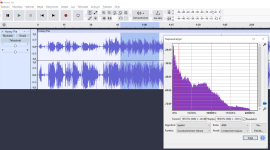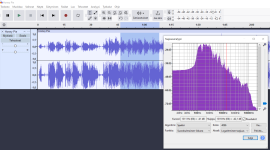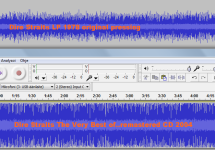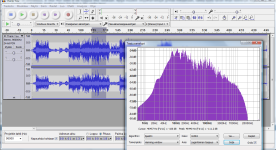Hello
just a quick comparison between a CD (16Bit/44,1KHz-Rip) and a LP (16Bit/48KHz-Rip).
Same song and same audio segment.
First: Audacity > Analyze > Plot Spectrum
CD
 LP
LP

Second: spec
CD

LP

I am amazed, i had expected a worse quality of the LP.
Thorens TD126 MK III + Ortofon OM20, Pioneer SX 950, ACER D270 for analog ripping.
Happy holidays to you all
just a quick comparison between a CD (16Bit/44,1KHz-Rip) and a LP (16Bit/48KHz-Rip).
Same song and same audio segment.
First: Audacity > Analyze > Plot Spectrum
CD
Second: spec
CD
LP
I am amazed, i had expected a worse quality of the LP.
Thorens TD126 MK III + Ortofon OM20, Pioneer SX 950, ACER D270 for analog ripping.
Happy holidays to you all
Last edited:
Do they sound the same to the ear?
My 780 sounded dull (-3db) on treble and muddy on bass compared to CD. I used brothers in arms and Fleetwood Mac greatest hits 2 as the test records.
My 780 sounded dull (-3db) on treble and muddy on bass compared to CD. I used brothers in arms and Fleetwood Mac greatest hits 2 as the test records.
I'm not sure what you are referring to when you invoke "quality of the LP". I think that there are better metrics to compare CD and LP reproduction than these... you are just showing the relative energy level of the segment, not distortion, rumble, etc. Also there does not seem to be much HF energy in this particular section of music.
The best vinyl playback chains are very good, and the difference between them and the best digital playback chains in terms of "quality" is mostly in the weeds of measurements and not all that perceptible to the ear. However, IMO to get and stay "at the top" with vinyl is costly and time consuming compared to digital music. As an example, at an audio show a guy on our "team" brought a 20k turntable plus a custom tweaked phono amp. It took him 40 minutes to set up and align, etc. Meanwhile we were playing digital music off of disk since there was nothing to do, no setup, no calibration, etc. Just plug and play.
It is clear that digital music comes out ahead in various metrics of playback quality if you are into the numbers game.
There is a very informative thread about the quality of vinyl playback here:
https://www.audiosciencereview.com/forum/index.php?threads/fun-with-vinyl-measurements.20278/
I am sure this thread will gather the usual flamethrowers! I will grab a beer and some popcorn now... 😄
The best vinyl playback chains are very good, and the difference between them and the best digital playback chains in terms of "quality" is mostly in the weeds of measurements and not all that perceptible to the ear. However, IMO to get and stay "at the top" with vinyl is costly and time consuming compared to digital music. As an example, at an audio show a guy on our "team" brought a 20k turntable plus a custom tweaked phono amp. It took him 40 minutes to set up and align, etc. Meanwhile we were playing digital music off of disk since there was nothing to do, no setup, no calibration, etc. Just plug and play.
It is clear that digital music comes out ahead in various metrics of playback quality if you are into the numbers game.
There is a very informative thread about the quality of vinyl playback here:
https://www.audiosciencereview.com/forum/index.php?threads/fun-with-vinyl-measurements.20278/
I am sure this thread will gather the usual flamethrowers! I will grab a beer and some popcorn now... 😄
Last edited:
Spectrum will not tell you much anything - masterings for vinyls and cd-s are usually different, on the vinyl playback side very much (of what you actually hear) is depending on cartridge, stylus and phono stage combination.You will find that the spectrum extends well above 21 kHz
However, IMO to get and stay "at the top" with vinyl is costly and time consuming compared to digital music. As an example, at an audio show a guy on our "team" brought a 20k turntable plus a custom tweaked phono amp. It took him 40 minutes to set up and align, etc. Meanwhile we were playing digital music off of disk since there was nothing to do, no setup, no calibration, etc. Just plug and play.
I found that at the gatherings of a Dutch audio forum, the people playing vinyl records usually have them playing in minutes, while those using streaming need hours to solve all computer networking issues. 😉
Correct you are, just plug and play in a second the opamp crippled stuff distributed under "music" label. Easy-peasy...Meanwhile we were playing digital music off of disk since there was nothing to do, no setup, no calibration, etc. Just plug and play.
If you have not heard the real analogue recordings from vinyl via a decent audio chain then you just do not know what you are missing.
From my experience, distortion is the big difference, specially if you play the last song in the vinyl (smallest radius).
A THD comparison for this case would be great to observe.
A THD comparison for this case would be great to observe.
How would you get this done in case of a vinyl playback?A THD comparison for this case would be great to observe.
Was the whole piece analyzed? If yes, that's too long
Please use logarithmic frequency scale!
use higher sample number!
Low end response is similar and that is very suspicous... as well above 15khz threre
I made similar comparison ten years ago, also with three decks and four cartridges... Also preamps can have different highpass filters.
CD's are often different mixes and more compressed than vinyls, which is because of >Loudness War (it must sound loud!)
Please use logarithmic frequency scale!
use higher sample number!
Low end response is similar and that is very suspicous... as well above 15khz threre
I made similar comparison ten years ago, also with three decks and four cartridges... Also preamps can have different highpass filters.
CD's are often different mixes and more compressed than vinyls, which is because of >Loudness War (it must sound loud!)
Attachments
@madis64 I think only if we had a test vinyl record with pure sine waves.
It seams there still are some available such as this one:
https://www.audioadvisor.com/ortr?sku=NEW-ORTR
It seams there still are some available such as this one:
https://www.audioadvisor.com/ortr?sku=NEW-ORTR
I found that at the gatherings of a Dutch audio forum, the people playing vinyl records usually have them playing in minutes, while those using streaming need hours to solve all computer networking issues. 😉
I use a laptop (Linux) and a multichannel DAC. There is no setup/networking to be done. After the usual cable connections, it requires only 20 seconds to boot and then play. Sorry about your Dutch friends and their problems!
There is more than one vinyl test record available - I have not yet seen one with pure sine on the last track.It seams there still are some available such as this one:
Was the whole piece analyzed? If yes, that's too long
Please use logarithmic frequency scale!
use higher sample number!
Low end response is similar and that is very suspicous... as well above 15khz threre
I made similar comparison ten years ago, also with three decks and four cartridges... Also preamps can have different highpass filters.
CD's are often different mixes and more compressed than vinyls, which is because of >Loudness War (it must sound loud!)
I'm surprised you see so little above 20 kHz. The last time I looked at the power spectrum of a record sampled with 96 kHz, it extended well above 30 kHz. Mind you, I don't remember what the vertical scale was.
5 pages in a linked forum thread - you wanted to say exactly what?Haha, THAT is noise!
Haha, THAT is noise and distortion!
https://hydrogenaud.io/index.php/topic,113365.0.html
This remark seems illogical to me. As far as I know, no brick-wall filters are used for recording analoguely mastered vinyl records, so it would be surprising if there were no content above 20 kHz.
Recordings can go very high to catch harmonics and distortions of original sound, but level is typically very low compared to pure tones (few %).
Cutting them on vinyl and playing back is difficult and finally loudspeakers will make mess of them... and anyway only bats could hear that!
https://www.channld.com/vinylanalysis1.html
ps. Linear frequency scale used earlier in this thread and in my link overemphasizes high frequencies. Logarithmic scale is the right one to use.


Cutting them on vinyl and playing back is difficult and finally loudspeakers will make mess of them... and anyway only bats could hear that!
https://www.channld.com/vinylanalysis1.html
ps. Linear frequency scale used earlier in this thread and in my link overemphasizes high frequencies. Logarithmic scale is the right one to use.


Last edited:
- Home
- Source & Line
- Analogue Source
- CD versus LP - a comparison of the frequency spectra


